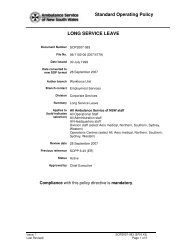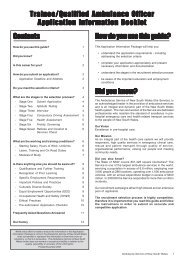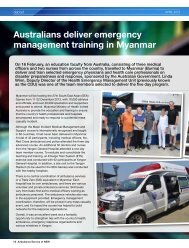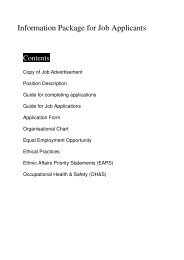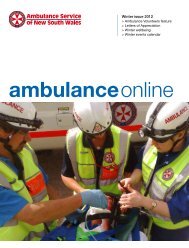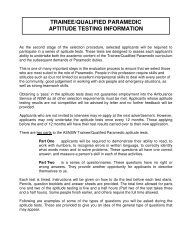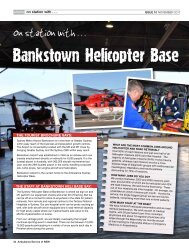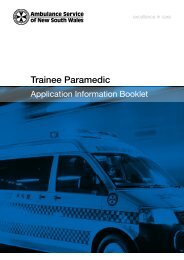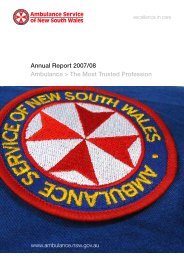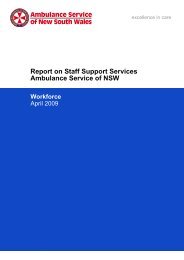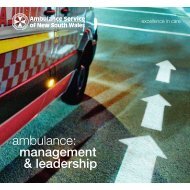Utilisation of patient transport crews, October 2008 - Ambulance ...
Utilisation of patient transport crews, October 2008 - Ambulance ...
Utilisation of patient transport crews, October 2008 - Ambulance ...
Create successful ePaper yourself
Turn your PDF publications into a flip-book with our unique Google optimized e-Paper software.
Standard Operating Policy<strong>Utilisation</strong> <strong>of</strong> Patient Transport CrewsDocument Number SOP<strong>2008</strong>-033File No. 08/230Date issued 16 <strong>October</strong> <strong>2008</strong>Author Branch General Manager OperationsBranch contact Evan ClarkDivision Operations - State HeadquartersSummary Outlines the policy for the utilisation <strong>of</strong> Patient TransportCrews.Applies to(bold indicatesselection)All <strong>Ambulance</strong> Service <strong>of</strong> NSW staffAll Operational StaffAll Administration staffAll Headquarters staffDivision staff (select Aero medical, Northern, Southern, Sydney,Western)Operations Centres (select All, Aero medical, Northern, Southern,Sydney, Western)Review date <strong>October</strong> 2010Previous reference This revised SOP replaces previous version <strong>of</strong> SOP<strong>2008</strong>- 030Status ActiveApproved by Chief ExecutiveCompliance with this policy directive is mandatory.SpaceSOP<strong>2008</strong>-033 Page 1 <strong>of</strong> 2
Standard Operating PolicyRationaleTo ensure the efficient and effective deployment <strong>of</strong> Patient Transport Officers.ProcedurePatient Transport Officers (PTOs) are an important resource and are only utilised for the undertaking<strong>of</strong> non-emergency <strong>transport</strong>. The following guidelines have been developed to assist deployment totheir full potential.The configuration <strong>of</strong> PTO vehicles is varied requiring the Operations Centre Officer to confirm thenumber and types <strong>of</strong> stretcher and seated <strong>patient</strong>s they are able to provide <strong>transport</strong> to at any onetime.• The internal configuration does have physical barriers as the dual stretchers restrict movementand therefore precludes <strong>transport</strong> <strong>of</strong> any <strong>patient</strong> requiring active clinical monitoring or treatment.• If an escort (nurse, police etc) is provided for the purpose <strong>of</strong> continuation <strong>of</strong> active clinical care,possible intervention and monitoring then a frontline <strong>Ambulance</strong> resource should be considered.• PTOs will only undertake routine and non-emergency <strong>transport</strong>s. Predominately, this would be DayTreatments and Convalescent <strong>patient</strong>s and some medicals may also be appropriate. Specifically,PTOs should be considered for utilisation on: All cases that require no active clinical treatment or monitoring. Priority 3 cases where <strong>patient</strong> is going for general admission – not to Casualty. Assist Loads Megalift stretcher cases – consult DOCO prior to allocation• For all Aero-medical <strong>transport</strong>s (Priority 4) cases, consideration should be given to the <strong>patient</strong>’sdiagnosis and any information indicating monitoring or IV therapy (active treatment) in progress ormay be required enroute. Air <strong>Ambulance</strong> will indicate if the case is appropriate for PTO <strong>transport</strong>.• Consideration should be given to avoid using PTOs for single <strong>patient</strong> long distance <strong>transport</strong>s. Itmay be more efficient to utilise a frontline ambulance and deploy the PTOs to areas <strong>of</strong> higherworkload.• In the event <strong>of</strong> a single PTO being rostered, consideration should be given to teaming the singlewith an <strong>Ambulance</strong> Officer to make a double team. In this instance however, the vehicle shallremain a <strong>patient</strong> <strong>transport</strong> vehicle and is not to be considered or utilised as an emergencyresource. Should any resistance be met then it will be referred to the area for determination.• It is appropriate that PTOs may advise Operations Centre Officers <strong>of</strong> their inability to undertake the<strong>transport</strong> <strong>of</strong> a <strong>patient</strong> due to the internal configuration <strong>of</strong> their vehicle or clinical level required.• PTOs must be provided with a 30 minute crib break between the 4 th and 7 th hour <strong>of</strong> their shift• PTOs are not to be used as an emergency response.SOP<strong>2008</strong>-033 Page 2 <strong>of</strong> 2



